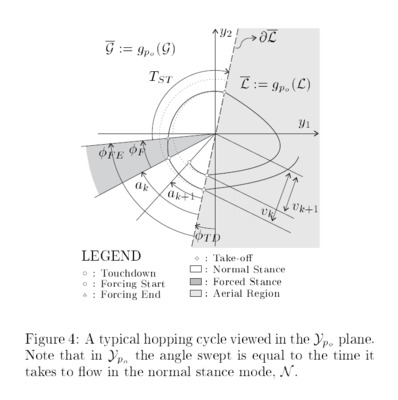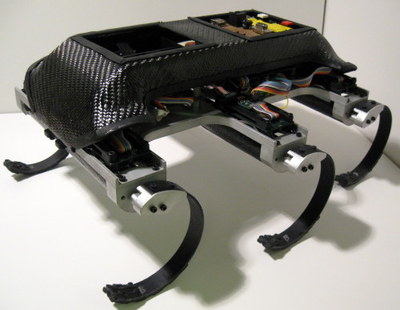We describe a method for the decentralized phase regulation of two coupled hybrid oscillators. In particular, we prove that the application of this synchronization method to two hopping robots, each of which individually achieves only asymptotically stable hopping, results in an asymptotically stable limit cycle for the coupled system exhibiting the desired phase difference. This extends our previous work wherein the application of the method to two individually deadbeat-stabilized oscillators (paddle juggling mechanisms) was shown to yield the desired result. Central to this method is the idea that cyclic systems may be composed into a larger, aggregate, cyclic system. Its application entails moving from physical coordinates (for example, the position and velocity of each constituent mechanism) to the coordinates of phase and phase velocity. Within this canonical coordinate system we construct a model dynamical system, called a reference field, which encodes the desired behavior of each cyclic system as well as the phase relationships between them. We then force the actual composite system to behave like the model.
Proprioception Based Behavioral Advances in a Hexapod Robot
We report on our progress in extending the behavioral repertoire of RHex, a compliant leg hexapod robot. We introduce two new controllers, one for climbing constant slope inclinations and one for achieving higher speeds via pronking, a gait that incorporates a, substantial aerial phase. In both cases, we make use of an underlying open-loop control strategy, combined with low bandwidth feedback to modulate its parameters. The inclination behavior arises from our initial alternating tripod walking controller and adjusts the angle offsets of individual leg motion profiles based on inertial sensing of the average surface slope. Similarly, the pronking controller makes use of a “virtual” leg touchdown sensing mechanism to adjust the frequency of the open-loop pronking, effectively synchronizing the controller with the natural oscillations of the mechanical system. Experimental results demonstrate good performance on slopes inclined up to /spl sim/250 and pronking up to speeds approaching 2 body lengths per second (/spl sim/1.0 m/s).
Assembly as a noncooperative game of its pieces: analysis of
We propose an event-driven algorithm for the control of simple robot assembly problems based on noncooperative game theory. We examine rigorously the simplest setting — three bodies with one degree of freedom and offer extensive simulations for the 2 DOF extension. The initial analysis and the accompanying simulations suggest that this approach may indeed, offer an attractive means of building robust event driven assembly systems.
Preliminary Analysis of a Biologically Inspired 1-DOF “Clock” Stabilized Hopper

We investigate the stability of a one degree of freedom mechanical spring-mass system modulated by a feed-forward “clock” that stiffens and relaxes a Hooke’s law potential force according to a periodic rhythm. At the present early stage of inquiry, we offer sufficient conditions for local asymptotic stability of an isolated periodic orbit when there is no feedback to the clock at all but some viscous friction in the mechanism. We conjecture that, absent feedback, a lossless mechanical system cannot exhibit an asymptotically stable limit cycle in response to such rhythmic excitation.
Approximating the Stance Map of a 2 DOF Monoped Runner
We report in this paper a relatively simple means of generating closed-form approximants to the return map associated with a family of nonintegrable Hamiltonian systems. These systems arise in consideration of legged locomotion by animals and robots. The approximations proceed through the iterated application of the mean value theorem for integral operators applied to a nonintegrable perturbation of the system of interest. Both the accuracy of these approximants and their algebraic intractability grow in a relatively controlled manner.
Rigid body visual servoing using navigation functions
Visual servo controllers in the literature rarely achieve provably large domains of attraction, and seldom address two important sensor limitations: (i) susceptibility to self-occlusions and (ii) finite field of view (FOV). We tackle the problem of global, occlusion-free visual servoing of a fully actuated rigid body by recourse to navigation functions on a compact manifold which encode these restrictions as control obstacles. For occlusion free rigid body servoing, the manifold of interest is the “visible” set of rigid body configurations, that is, those for which the feature points are within the field of view and unoccluded by the body. For a set of coplanar feature points on one face of a convex polyhedron, we show that a slightly conservative subset of the visible set has a simple topology amenable to analytical construction of a navigation function. We construct the controller via a closed form coordinate transformation from our problem domain into the topological model space and conclude with simulation results.
Dynamic locomotion with four and six-legged robots
Stable and robust autonomous dynamic locomotion is demonstrated experimentally in a four and a six-legged robot. The Scout II quadruped runs on flat ground in a bounding gait, and was motivated by an effort to understand the minimal mechanical design and control complexity for dynamically stable locomotion. The RHex 0 hexapod runs dynamically in a tripod gait over flat and badly broken terrain. Its design and control was motivated by a collaboration of roboticists, biologists, and mathematicians, in an attempt to capture specific biomechanical locomotion principles. Both robots share some basic features: Compliant legs, each with only one actuated degree of freedom, and reliance on (task space) open loop controllers.
Piecewise Linear Homeomorphisms: The Scalar Case
The class of piecewise linear homeomorphisms (PLH) provides a convenient functional representation for many applications wherein an approximation to data is required that is invertible in closed form. In this paper we introduce the graph intersection (GI) algorithm for “learning” piecewise linear scalar functions in two settings: “approximation,” where an “oracle” outputs accurate functional values in response to input queries; and “estimation,” where only a fixed discrete data base of input-output pairs is available. We provide a local convergence result for the approximation version of the GI algorithm as well as a study of its numerical performance in the estimation setting. We conclude that PLH offers accuracy closed to that of a neural net while requiring, via our GI algorithm, far shorter training time and preserving desired invariant properties unlike any other presently popular basis family.
A formalism for the composition of concurrent robot behaviors
We introduce tools which help one to compose concurrent, hybrid control programs for a class of distributed robotic systems, assuming a palette of controllers for individual tasks is already constructed. These tools, which combine the backchaining of continuous robot behaviors with Petri nets, expand on successful work in sequential composition of robot behaviors. We apply these ideas to the design and verification of a robotic bucket brigade and to simple, distributed assembly tasks as found in automated factories.
Event Driven Parts Moving in 2D Endogenuous Environments

This paper is concerned with the parts’ moving problem based on an event-driven planning and control. We are interested in developing feedback based approaches to the automatic generation of actuator commands that cause the robot to move a set of parts from an arbitrary initial disassembled configuration to a specif ed final configuration. In the Phase I of this project, a composite algorithm that reactively switches between different feedback controllers has been shown to induce a noncooperative game being played among the parts being manipulated. This paper describes experimental results with EDAR – Event-Driven Assembler Robot – developed for moving parts based on feedback techniques.
For more information: Kod*Lab


